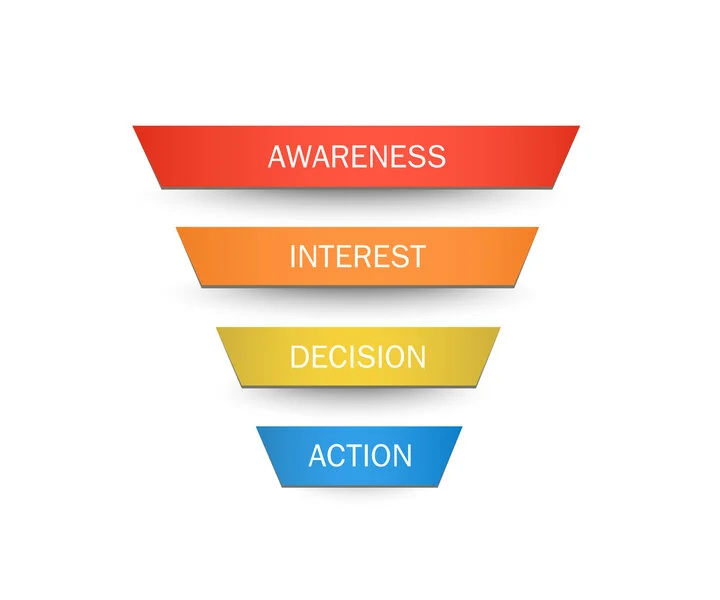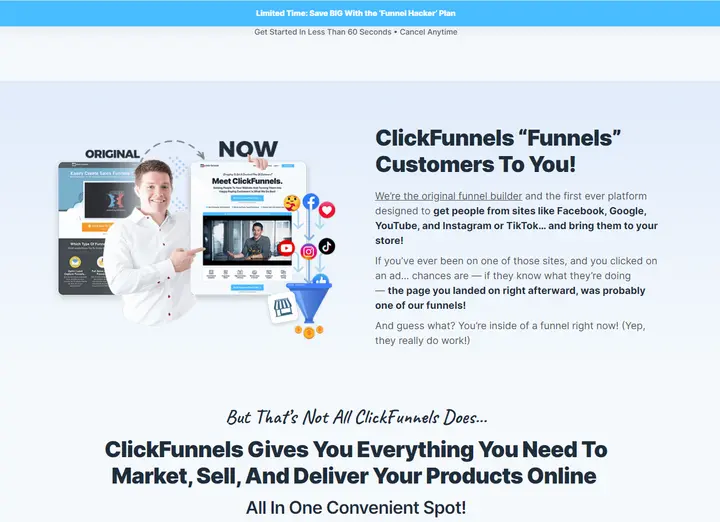Table of Contents
“What is a sales funnel in marketing?” This question is at the heart of understanding the customer acquisition and retention process that is pivotal for any successful marketing campaign. A sales funnel is not just a buzzword; it’s a strategic framework that guides potential customers on their journey from first contact to final purchase, and even beyond. In this comprehensive guide, we’ll explore the mechanics of sales funnels, why they’re critical for your marketing success, and how tools like ClickFunnels can help you optimize this journey to yield tangible results. Whether you’re a seasoned marketer or new to the field, understanding the sales funnel concept is key to converting leads and boosting your bottom line.
The Concept of a Sales Funnel
At the heart of every successful marketing strategy lies a fundamental question: What is a sales funnel in marketing? A sales funnel is a strategic model that depicts the theoretical journey a customer embarks upon when making a purchasing decision. It’s conceptualized as a funnel because it represents the narrowing down of a broad audience to a smaller group of individuals who are poised to buy.
The Sales Funnel Framework
The framework of a sales funnel is divided into several phases, each corresponding to a different stage of the customer’s journey. It begins with ‘Awareness,’ where potential customers first learn about a product or service. As these prospects become more engaged, they move into the ‘Interest’ stage, where they start to show curiosity and look for more information. From there, they transition into ‘Desire,’ indicating a deeper interest or inclination toward the product. The final stage is ‘Action,’ where the customer makes a purchase decision.
The Role of the Sales Funnel in Marketing
Understanding what a sales funnel in marketing allows businesses to craft tailored messages and campaigns that align with each phase. By doing so, marketers can effectively guide potential customers through the funnel, significantly increasing the chances of converting leads into sales. This approach not only helps in efficiently allocating marketing resources but also enables businesses to measure the effectiveness of their strategies at different stages of the customer journey.
Visualizing the Sales Funnel
A sales funnel is not just a concept but also a visual representation of the volume of potential customers at each stage of the buying process. It helps marketers visualize the flow and drop-off of prospects, providing insights into which stages need more attention or better strategies to maintain customer engagement.
Key Stages of a Sales Funnel
Understanding the key stages of a sales funnel is crucial for anyone delving into the vast domain of marketing. But what is a sales funnel in marketing, and how does it break down? Essentially, it’s a process that companies use to turn someone unfamiliar with their brand into a customer. This process is often visualized as a funnel because it starts broad at the top and narrows down towards the bottom as prospects get closer to making a purchase.
Awareness: The Entry Point
The top of the funnel is all about awareness. It’s where potential customers first come into contact with a brand or product. At this stage, the goal is to stand out and make an impression. Marketing efforts here are focused on visibility through social media campaigns, blog posts, advertisements, and any other means to draw in as many people as possible.
Interest: Sparking Curiosity
As prospects move down the funnel, they enter the interest stage. Here, they start to show curiosity about the product or service. Content that educates and informs, such as ebooks, webinars, or detailed blog posts, works well at this stage. This is the point at which a brand can establish itself as a thought leader and a trustworthy source of information.

Decision: Evaluation
In the decision stage, prospects are considering whether or not to buy. They may compare different products, read reviews, and look at pricing options. Here, marketing should highlight the product’s unique value proposition and include social proof like testimonials or case studies to build trust and credibility.
Action: Conversion
The final stage of the sales funnel is action, where the prospect becomes a customer. It’s critical to make this step as easy and frictionless as possible. Calls to action need to be clear and persuasive, and the checkout process streamlined. Post-purchase follow-up can also be considered part of this stage, ensuring customer satisfaction and fostering loyalty.
By understanding these key stages of a sales funnel, marketers can craft targeted strategies to engage and convert prospects effectively. Each stage requires different marketing tactics, and knowing what is required at each point in the sales funnel is key to guiding prospects efficiently toward making a purchase.
Why Sales Funnels are Essential in Marketing
Grasping why sales funnels are essential in marketing is pivotal for any business aiming to streamline its marketing strategy and maximize its conversion rates. But precisely, what is a sales funnel in marketing? It’s a strategic model that captures the various stages a customer goes through before purchasing. Let’s delve into why this model is indispensable for successful marketing campaigns.
Streamlining the Path to Purchase
Sales funnels provide a systematic method for tracking and nurturing leads as they move through different stages of the buying process. They offer a structured framework that helps businesses understand and cater to the evolving needs of their customers. By knowing which stage a potential customer is in, marketers can deliver targeted messages and offers, thereby enhancing the likelihood of conversion.
Enhancing Customer Experience
A well-designed sales funnel goes beyond mere transactions; it enhances the overall customer experience. By engaging customers with relevant information and support at each stage, businesses can build stronger relationships and improve customer satisfaction. This attention to the customer journey fosters trust and loyalty, which are cornerstones of repeat business and referrals.
Increasing Conversion Rates
The primary goal of a sales funnel is to convert prospects into paying customers. By nurturing leads at each stage of the funnel, businesses can increase their conversion rate more effectively than with a one-size-fits-all approach. Sales funnels allow for personalized interactions that guide potential customers to a well-timed sale.
Data-Driven Decision Making
Sales funnels are essential in gathering data on customer behavior, preferences, and pain points. This data is invaluable for making informed marketing decisions and for optimizing future campaigns. By analyzing funnel performance, marketers can identify where prospects drop out and refine their strategies accordingly.
Cost-Effectiveness
Understanding and implementing an effective sales funnel can significantly reduce marketing costs. By focusing efforts on prospects who are more likely to convert, businesses can allocate their budgets more efficiently and achieve a higher return on investment.
In conclusion, sales funnels are not just a component of marketing; they are the backbone of a strategic marketing approach. They facilitate a more personalized and engaging experience for potential customers, enhance conversion rates, and enable data-driven decisions, all of which contribute to the overall success of a business’s marketing efforts.
Tools and Technologies for Crafting Effective Sales Funnels
In exploring what a sales funnel in marketing is, it’s crucial to recognize the tools and technologies that can build and optimize these powerful structures. Sales funnels have evolved from theoretical concepts into measurable, actionable marketing strategies, thanks in large part to a host of specialized software solutions.
ClickFunnels is perhaps the most recognized of these tools, offering users a drag-and-drop interface that simplifies the creation of each funnel stage. It’s complemented by integrated analytics to track a customer’s journey and conversion rates. Similarly, tools like Leadpages and System.IO allow marketers to create landing pages that are pivotal for capturing leads at the top of the sales funnel.
For those at the decision-making stage, CRM systems like Salesforce and HubSpot can be invaluable. They help track interactions with potential customers, ensuring that no opportunity for engagement is missed. Email marketing software such as Mailchimp or ActiveCampaign plays a critical role in nurturing leads through automated sequences, keeping the interest alive until the final purchase.
Implementing these tools effectively requires a solid understanding of the sales funnel concept. They are not just facilitators but enhancers of the marketing strategy, turning the theoretical pathways of a sales funnel into tangible customer experiences.
Common Mistakes to Avoid in Sales Funnel Marketing
Understanding what a sales funnel in marketing is also involves recognizing the common pitfalls that can derail its effectiveness. Avoiding these mistakes is as crucial as implementing the funnel itself.
Firstly, neglecting the top of the funnel can lead to a weak foundation for potential conversions. It’s essential not to focus solely on the end goal of making sales but also to invest in building awareness and capturing interest.
Another frequent misstep is not nurturing leads properly through the middle of the funnel. Customers in the consideration phase often need more information and reassurance before they’re ready to commit. Failing to provide this support can result in a significant drop-off in potential sales.
Additionally, a lack of clear calls-to-action (CTAs) can leave customers confused about the next steps. Every stage of the funnel should have a well-defined CTA to guide the customer smoothly to the next phase.
Lastly, failing to analyze and adjust your funnel based on performance data is a critical error. Continuous testing and tweaking are necessary to ensure the funnel remains effective and responsive to customer behavior.
By steering clear of these common errors, marketers can ensure their sales funnel is optimized for the best possible performance, leading to higher engagement and increased sales.
Case Studies and Success Stories: ClickFunnels in Action
Exploring “What is a sales funnel in marketing?” often leads to the discovery of ClickFunnels as a pivotal tool for marketers seeking to navigate the complexities of digital sales pathways successfully. Numerous case studies and success stories highlight how ClickFunnels has transformed marketing strategies and outcomes across industries.
One compelling narrative involves an e-commerce brand that leveraged ClickFunnels to revitalize its stagnant sales. By optimizing their sales funnel to enhance user engagement and streamline the purchasing process, they witnessed a significant uptick in conversions and customer retention.
Conclusion: “What is a sales funnel in marketing?”
In the journey to understand “What is a sales funnel in marketing?” we have uncovered the intricacies of how a well-structured sales funnel can be the lifeline of a business’s marketing strategy. ClickFunnels, with its robust toolkit, has emerged as a beacon for marketers, empowering them to craft funnels that not only captivate and convert but also cultivate lasting customer relationships.
As we’ve seen through various case studies and success stories, the impact of a finely tuned sales funnel is undeniable. It is the vehicle that drives prospects through the buyer’s journey, the map that guides them from initial awareness to final purchase, and the strategy that businesses of all sizes can leverage to scale new heights in the digital marketplace.
Remember, the question “What is a sales funnel in marketing?” is more than just a query—it’s a call to action for businesses to embrace the systematic approach of guiding potential customers toward making informed and enthusiastic purchases. As you embark on refining or creating your sales funnel, let the insights and best practices outlined here light your path to success.




